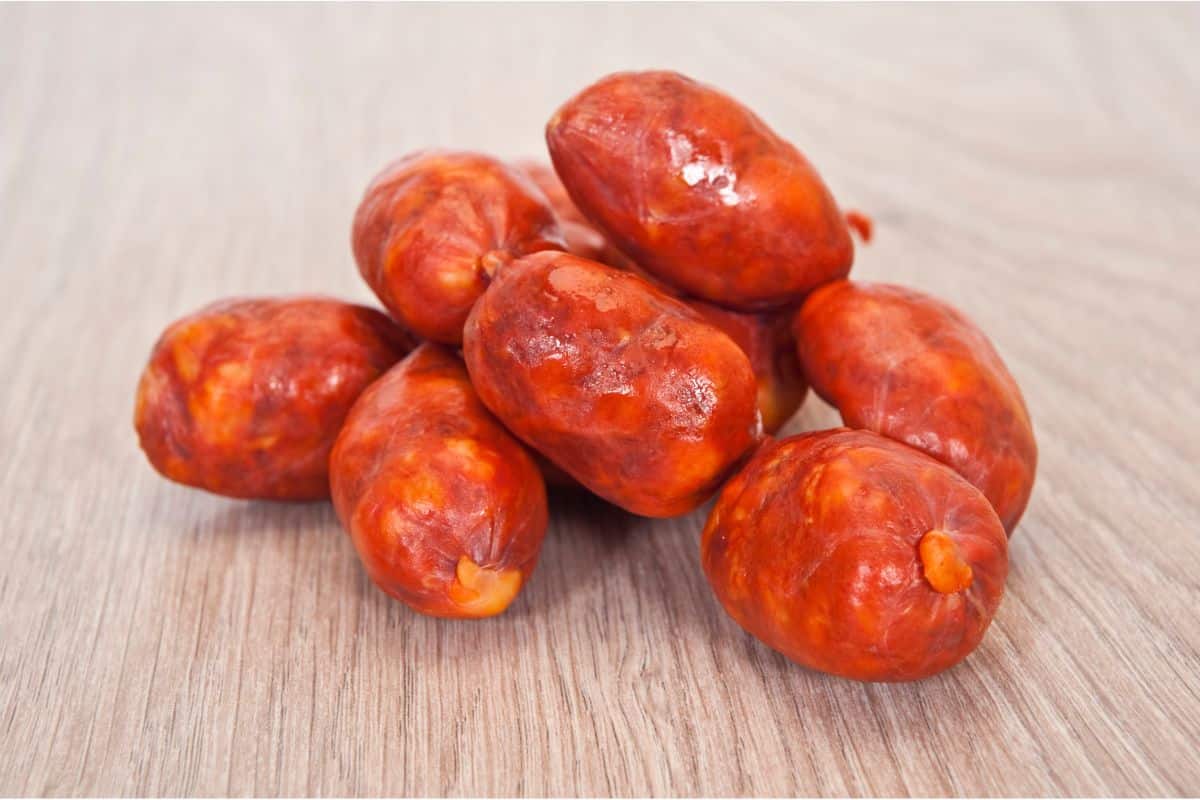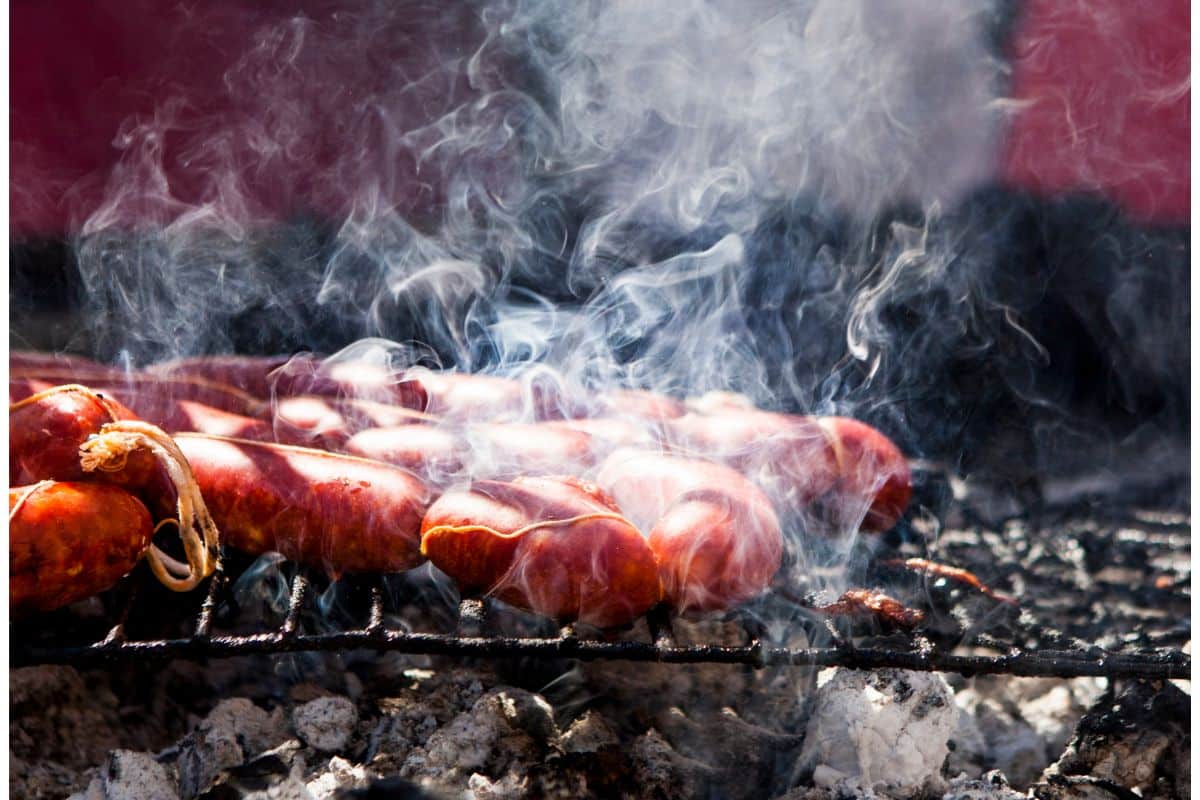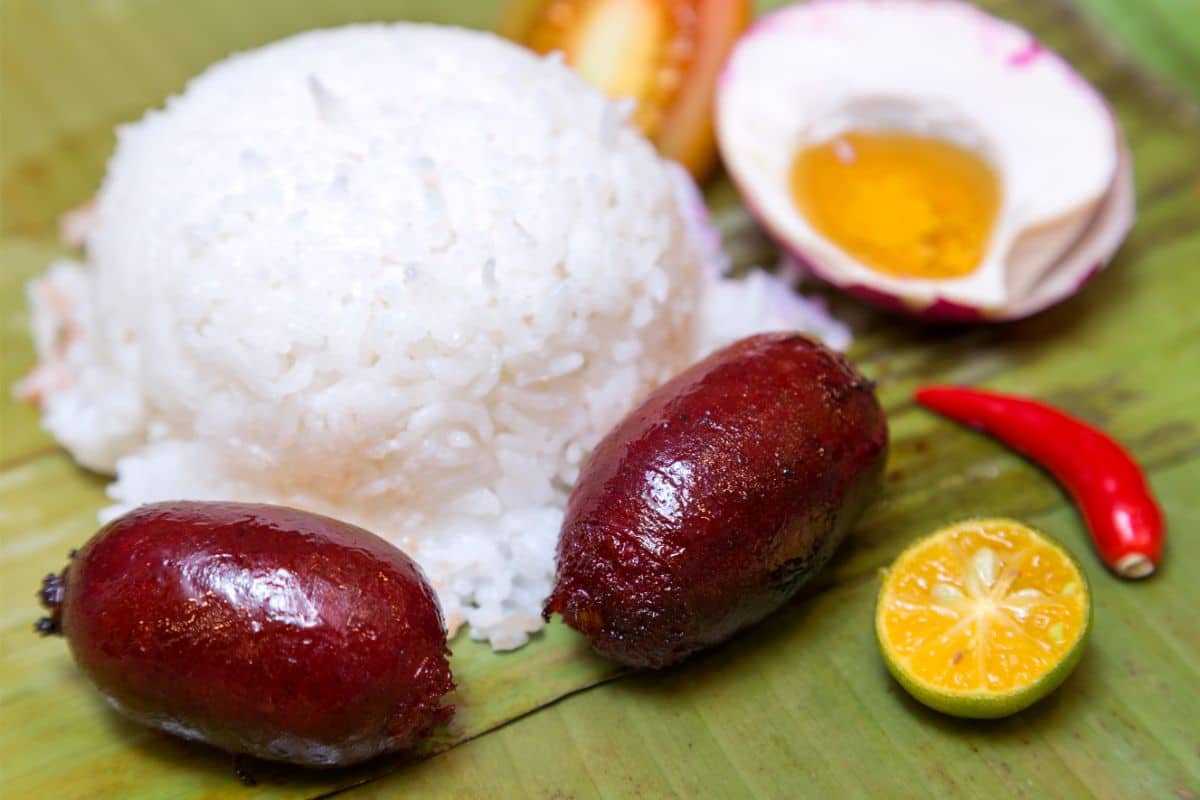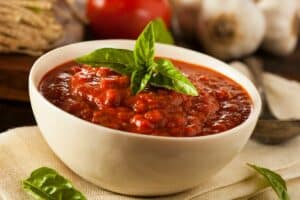Longaniza and chorizo are two of the most popular varieties of sausage meat in the world, but how do they compare?

Like all sausages, these two are made with a combination of meat and spices that reflect the local flavors loved in their native lands.
Filled with spices, delicious cuts of meat, and aromatic herbs, these sausages are a fool-proof way to add a hearty kick to your favorite meals.
So, what exactly are these sausages, and how do they compare? Let’s take a closer look at the differences between longaniza and chorizo.
What Is Longaniza?
Longaniza is a type of Spanish sausage made from minced meat.
It’s one of the most highly regarded sausages in the world, and it bears a resemblance to the Portuguese sausage that can be found in a variety of cuisines.
Longaniza is often considered a ‘summer sausage’, and it has a long, thin shape with a semi-solid texture that may remind you of salami.
Longaniza also has a rather peppery, spicy taste compared to other sausages.
Longaniza can be cold meat, cured, or fresh.
The main ingredients in Longaniza sausage are:
- Ground pork
- Kosher or sea salt
- Garlic
- Black peppers
- Cumin powder
- Seville orange juice
What Is Chorizo?
Chorizo is a type of pork sausage that’s generously seasoned and either chopped or ground.
It can be found in many Spanish and Mexican dishes, and it can be eaten without cooking.
Chorizo has a rather coarse texture, and although it’s usually made from pork, it can sometimes be made with bacon and other meats such as beef or venison, too.
Once it’s been made, this sausage is usually sealed in a type of casing made from animal intestines.
The main ingredients in Chorizo are:
- Ground pork
- Kosher salt
- Ancho chile powder
- Red paprika powder
- Cayenne pepper powder
- Ground cumin powder
- Ground black pepper
- Garlic
- Oregano
Chorizo and Longaniza are just a few varieties of sausages available.
There are plenty of other varieties, all of which are seasoned with a collection of spices and other ingredients, rolled in piping bags or sticks to prepare their structure, and cooked in different ways.
The taste and texture of sausage meat will differ depending on how it’s cooked, what seasonings are used, and what meat is used.
Different Varieties Of Chorizo
Longaniza isn’t the only sausage with Spanish origins. Chorizo also has some roots in Spain, and it’s particularly popular in Mexico.
Mexican chorizo is often spicier and sold raw, whereas Spanish chorizo is usually sold smoked or cured.
You may also hear chorizo being called by other names. In areas like Louisiana, chorizo is sometimes called the Cajun sausage.
In most areas of the US, you can buy chorizo fully cooked, and you’ll find it has a pretty similar texture to pepperoni or salami.
You can also buy chorizo semi-cured, depending on your preferences.
The Differences Between Longaniza And Chorizo
These sausages may look pretty similar, but their tastes and textures are vastly different. Here’s a closer look at some of the biggest differences between longaniza and chorizo:
Their Origins
Longaniza sausage is thought to have originated in Spain, and it’s still used frequently throughout the country in a variety of interesting dishes.
Although the origins of Chorizo are still up for debate, it’s thought that this sausage actually originates elsewhere in Europe, and it’s mainly used in Mexico.
This is also why the tastes of longaniza and chorizo differ so much because they rely on the dominant spices in their native regions to give them their flavor.
Their Spices
As we’ve just mentioned, the spices used in these sausages have a pretty big impact on their flavor. Both longaniza and chorizo use different spices to enhance the flavors of their meat.
Longaniza uses spices popular in European dishes, such as paprika, garlic, and sometimes even cinnamon, cloves, and nutmeg.
However, chorizo uses spices most often found in Mexican dishes, such as fresh cayenne, chili powder, and paprika.
The Type Of Meat
Although both of these sausages use pork, they use different cuts which affects their flavor. Longaniza is usually made from pork shoulder, while chorizo is made from minced meat.
This affects both the flavor and texture of the sausage.
Cooking Methods

Both of these sausages need to be cooked in slightly different ways.
For example, longaniza requires a shorter cooking time, and it’s often pan-seared or baked as the entire sausage link, whereas chorizo is usually prepared smoked with garlic and paprika.
Their Spiciness
The spiciness of these sausages is another of their biggest differences.
Chorizo is often much spicier than Longaniza, which is why chorizo is often used to complement other spicy dishes or bring more heat to dull dishes.
Longaniza doesn’t rely on much spice to give it its flavor.
Mexican Vs. Filipino Longaniza
Although Mexican longaniza is the most common variety, there is also Filipino longaniza.
Mexican longaniza is slightly spicy and usually made from pork. It’s seasoned generously, and once it’s cooked, the sausages are then dried and smoked.
However, Filipino longaniza is a little different.
This longaniza can be made from several types of meat, including beef, pork, tuna, and chicken, and it’s seasoned generously with brown sugar, garlic, salt, black pepper, and even vinegar.
Some varieties include even more spices, but this sausage tends to be sweet or garlicky and lacks the spice that traditional longaniza brings to the table.
How To Eat Chorizo
There are many ways to enjoy chorizo, but you’ll usually find it paired with cheese on a charcuterie board, and it can even be paired with eggs and enjoyed for breakfast!
Here are some other dishes that commonly include chorizo:
- Tacos
- Burritos
- Meatballs
- Chili
- Stews
- Soups
- Poultry stuffing
You can also eat chorizo inside of, or removed from its casing. Spanish chorizo is usually eaten inside its casing, while Mexican chorizo is removed.
When you’re preparing chorizo, you probably won’t need to add any extra oil to your recipes.
Chorizo already has a pretty high fat content, and the fat found naturally inside the pork will help melt and cook the sausage.
How To Cook Chorizo
Whether you’re adding it to a soup, stew, or a spicy taco, chorizo is a quick and easy way to add a flavorsome kick to your dish.
There are many ways to cook chorizo, but broiling, grilling, and pan-frying are the most popular. We’ll take a closer look at how to use these methods below:
Grilling
To grill your chorizo to perfection, follow the steps below:
- Preheat your grill
- Once hot, place your prepared chorizo on the grill and space each piece out evenly to ensure it cooks thoroughly
- Now, keep your grill hot by placid the lid over your chorizo, and leave it to cook
- Your chorizo should take between 15-20 minutes to cook through. You’ll know it’s done when your chorizo has reached a temperature of 160 degrees Fahrenheit. We’d recommend rotating your chorizo every few minutes to ensure it cooks evenly on each side. Insert a meat thermometer into your chorizo to ensure it’s cooked all the way through
Pan Frying
Pan-frying is one of the most popular and efficient ways to cook chorizo. Here’s how to cook your chorizo on the stovetop:
- Heat your pan over medium heat, to allow the flavors to develop. Avoid using a high heat, as this will burn your chorizo links before they cook through
- Once you’ve heated up your pan, you can add chorizo and water. We’d recommend adding at least six tablespoons of water to your pan, and cook it alongside your chorizo links. Put the liver over the pan, and let your chorizo cook for at least 10 minutes, turning frequently
- After ten minutes, you can take the lid off of your chorizo and leave it to cook for an extra 5-7 minutes until it’s golden brown and hot
- Once your chorizo is cooked through, you can go ahead and plate it up!
Pro tip: If you want to spice up the texture of your chorizo, why not crumble it? Crumbling your chorizo can give you a texture that’s similar to ground beef.
You can do this by cutting a long, thin slit lengthwise into your chorizo link, and then squeezing the meat into the pan.
As your chorizo starts to cook through, it will become pretty greasy, so be sure to drain away any excess fat at the end.
Broiling
You may also prefer to broil your chorizo. Broiling involves cooking food by exposing it to direct, radiant heat.
You can think of it as upside-down grilling! Here’s how to do it:
- Preheat your oven, turn on the broiling setting, and leave time for your oven to heat up
- Place your chorizo on the broiler rack, and ensure there are at least seven inches between your chorizo and the heating element
- You can now leave your chorizo to broil for around 15 minutes on each side, and until it’s golden brown on either side
How To Cook Longaniza
Although you can cook longaniza in all of the same ways as chorizo, we have a preferred method that we’ll share with you below. To cook your longaniza, you’ll need:
- 1 package of frozen, uncooked longaniza
- ½ cup of water
- 2 tbsp of oil (optional)
Method
- Put your frozen longaniza in a pan, and add 1⁄2 cup of water. Cook your longaniza on medium to low heat, and cover the pan with the lid.
- Now, leave your longaniza to simmer until the water starts to evaporate and the oil is released. Longaniza will fry in its own oil, but keep an eye on the pan and see if you need to add any of your own.
- If you need to, reduce the heat of your pan to stop the longaniza burning.
- After a couple of minutes of cooking, start to separate your longaniza using a knife or scissors. Before you chop your longaniza, use a fork to poke each piece of sausage and reduce any build-up of excess oil.
- You can now flip your longaniza on all sides until it starts to brown evenly. If you like your longaniza to have a crispier coating, leave it to cook for a little longer on the outside.
Now, your longaniza is ready to serve! We’d recommend dishing it up with a generous helping of tomatoes and rice for a filling, flavorsome dish. Enjoy!
If you’ve never cooked longaniza before, here are a few tips to help you cook it correctly, and ensure you get the tastiest results:
- Always add at least ½ a cup of water to the pan when you’re cooking, and cook your longaniza on medium to low heat. Longaniza can burn fast, so never fry it on high heat.
- Don’t start poking your longaniza with a fork before you cook it. This can release the oil inside the sausage, which you DON’T want. The longaniza will naturally cook in its own oil and juices, so don’t start poking it with a fork until it’s already been cooking for a few minutes. This will help release any excess oil into the pan and allow your longaniza to cook in it.
- Don’t add any extra oil to the pan before you start cooking. Longaniza will release its own oils as it cooks – if you add too much, you’ll end up with a super greasy, unpleasant sausage.
- When the water starts to evaporate during cooking, the longaniza will start to fry. If this doesn’t happen, add a few tablespoons of oil. Just be careful, as longaniza tends to burn quickly. Reduce the heat if needed.
- Once your longaniza has fried for a few minutes, you can go ahead and separate each piece. Do this by taking a fork and poking each piece gently. We’d recommend using the pan lid as a shield to protect your hands, as the longaniza is likely to spit hot oil. Once you’ve separated each piece, it’ll be easier to flip your sausage during cooking and ensure each side gets cooked evenly.
Longaniza Vs. Chorizo: Which Is Healthier?

These pork sausages are both famous for their spicy flavors and versatility.
Although they share a few similarities, they’re actually pretty different in terms of their health benefits, flavor, ingredients, and more.
Generally, longaniza is considered to be a ‘leaner’ sausage and a healthier alternative to chorizo.
Although longaniza, like most sausages, still contains some fat, it often has a much lower saturated fat content than chorizo, and it also contains more protein, making it a great alternative for anyone watching their waistline.
Longaniza also has a milder taste than chorizo.
Although longaniza may be a better alternative for those on a diet, both of these sausages still contain high levels of sodium, so they should be consumed in moderation.
Ultimately, though, longaniza is still considered a healthier alternative to chorizo.
However, you should be aware that there are many varieties of longaniza out there, and some are considered more unhealthy than chorizo.
This will depend on the ingredients in your sausage, including what kind of meat is used.
Calories In Longaniza And Chorizo
Talking of watching your waistline, let’s take a closer look at the difference in calorie content between longaniza and chorizo.
As we mentioned earlier, not all types of longaniza are made equal. Surprisingly, some varieties of longaniza can actually contain more calories than chorizo.
Around 100g of longaniza contains approximately 360 calories, while 100g of chorizo comes in at around 300 calories.
However, their sodium content is always roughly equal. Although their fat contents can be the same, some varieties of longaniza can contain more.
When you’re shopping for longaniza, you’ll need to pay close attention to the ingredients to determine which is healthiest.
Consider both the fat and calorie content in each sausage to help you determine which variety is best for you.
Both longaniza and chorizo have pretty unique flavor profiles that are destined to please all sorts of palettes.
Although the ingredients, taste, appearance and usage of these sausages can differ, in other ways, they can be pretty similar.
The good news is that both varieties are super tasty, so even if you’re watching your waistline, you can still enjoy all the great flavors of these sausages!
What Turns Chorizo And Longaniza Red?
The spices used in both longaniza and chorizo are often what turns them red.
Although the spices can vary significantly depending on which region the sausages are processed in, they almost always contain chili peppers and garlic.
These simple spices are what give both chorizo and longaniza their distinctive, deep red hues.
Do You Need To Cook Longaniza And Chorizo Before Using Them?
If your longaniza or chorizo is not pre-cured, you will definitely need to cook them before eating them.
However, if the meat has been cured, it can be eaten without needing to cook it at home.
Chorizo is often sold cured, but some varieties of longaniza are not, so always check the packaging first.
If your sausage meat has been cured, it will have a distinctive smell, flavor, and texture, and will usually resemble pepperoni.
Longaniza And Chorizo: The Primary Comparisons
As we near the end of our ultimate guide to longaniza and chorizo, here are a few primary comparisons to consider before choosing one:
- Both sausages have a deep red color
- Chorizo and longaniza are both spiced differently. Chorizo is often spicier, but some varieties of longaniza can be spicier than chorizo
- Chorizo is chopped and ground, but longaniza meat is finely minced
- The links of longaniza are thin and long, while chorizo links can vary according to their blend
- They can both be used in similar recipes
- Longaniza is rarely cured, while chorizo often is
- Chorizo is preferred as a ground meat, while longaniza is often cooked as a whole link
The Final Verdict: What’s The Difference Between Chorizo And Longaniza?
On the surface, these sausages may seem pretty similar. In reality, though, they’re very different and are often not used interchangeably in their dishes.
Although they’re both usually made from pork, longaniza can also be made from a mixture of fat and cartilage, and chorizo is ground, rather than minced.
Once you taste these sausages, you’ll be able to tell the difference between the two pretty quickly.
Paprika is the dominant spice in chorizo, while longaniza relies more on garlic and pepper to give it its flavor.
Either way, if you’re a sausage enthusiast with a love of warm, spicy flavors, you’ll love both of these delicious sausages!
The Bottom Line
At first glance, you’d be forgiven for thinking longaniza and chorizo are the same.
However, these sausages are actually pretty different, and they both add their own unique flavors, textures, and dimensions to your dishes.
Although they can be found in different cuisines throughout the world, you’ll usually find longaniza and chorizo in Mexican-inspired dishes such as burritos and tacos.
If you haven’t tried them yet, what are you waiting for? Spice up your usual cuisine in new ways with these unforgettable sausage meats!







